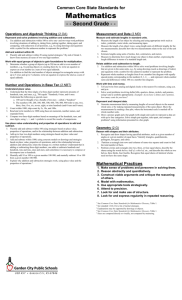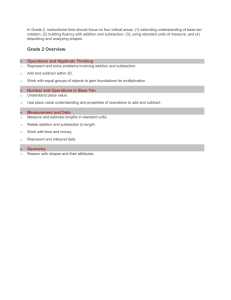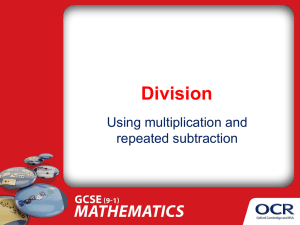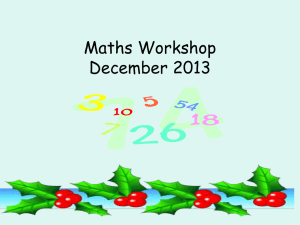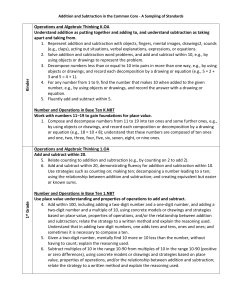2nd Grade Math Curriculum: Measurement, Numbers, & Shapes
advertisement
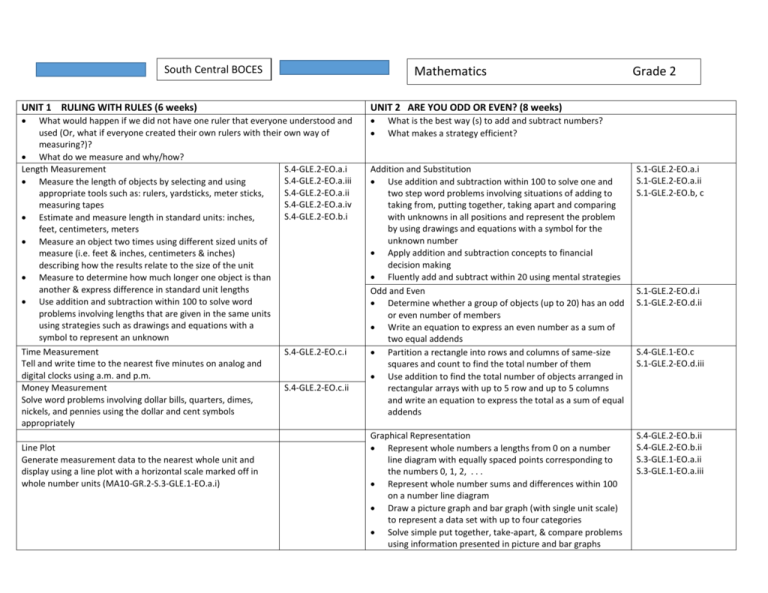
South Central BOCES Mathematics UNIT 1 RULING WITH RULES (6 weeks) UNIT 2 ARE YOU ODD OR EVEN? (8 weeks) What would happen if we did not have one ruler that everyone understood and used (Or, what if everyone created their own rulers with their own way of measuring?)? What do we measure and why/how? Length Measurement S.4-GLE.2-EO.a.i S.4-GLE.2-EO.a.iii Measure the length of objects by selecting and using S.4-GLE.2-EO.a.ii appropriate tools such as: rulers, yardsticks, meter sticks, S.4-GLE.2-EO.a.iv measuring tapes S.4-GLE.2-EO.b.i Estimate and measure length in standard units: inches, feet, centimeters, meters Measure an object two times using different sized units of measure (i.e. feet & inches, centimeters & inches) describing how the results relate to the size of the unit Measure to determine how much longer one object is than another & express difference in standard unit lengths Use addition and subtraction within 100 to solve word problems involving lengths that are given in the same units using strategies such as drawings and equations with a symbol to represent an unknown Time Measurement Tell and write time to the nearest five minutes on analog and digital clocks using a.m. and p.m. Money Measurement Solve word problems involving dollar bills, quarters, dimes, nickels, and pennies using the dollar and cent symbols appropriately Line Plot Generate measurement data to the nearest whole unit and display using a line plot with a horizontal scale marked off in whole number units (MA10-GR.2-S.3-GLE.1-EO.a.i) S.4-GLE.2-EO.c.i S.4-GLE.2-EO.c.ii Grade 2 What is the best way (s) to add and subtract numbers? What makes a strategy efficient? Addition and Substitution Use addition and subtraction within 100 to solve one and two step word problems involving situations of adding to taking from, putting together, taking apart and comparing with unknowns in all positions and represent the problem by using drawings and equations with a symbol for the unknown number Apply addition and subtraction concepts to financial decision making Fluently add and subtract within 20 using mental strategies Odd and Even Determine whether a group of objects (up to 20) has an odd or even number of members Write an equation to express an even number as a sum of two equal addends Partition a rectangle into rows and columns of same-size squares and count to find the total number of them Use addition to find the total number of objects arranged in rectangular arrays with up to 5 row and up to 5 columns and write an equation to express the total as a sum of equal addends S.1-GLE.2-EO.a.i S.1-GLE.2-EO.a.ii S.1-GLE.2-EO.b, c Graphical Representation Represent whole numbers a lengths from 0 on a number line diagram with equally spaced points corresponding to the numbers 0, 1, 2, . . . Represent whole number sums and differences within 100 on a number line diagram Draw a picture graph and bar graph (with single unit scale) to represent a data set with up to four categories Solve simple put together, take-apart, & compare problems using information presented in picture and bar graphs S.4-GLE.2-EO.b.ii S.4-GLE.2-EO.b.ii S.3-GLE.1-EO.a.ii S.3-GLE.1-EO.a.iii S.1-GLE.2-EO.d.i S.1-GLE.2-EO.d.ii S.4-GLE.1-EO.c S.1-GLE.2-EO.d.iii UNIT 3 DO ALL HALVES LOOK THE SAME? (4 weeks) UNIT 4 WHAT DOES 10 HAVE TO DO WITH 1000? (12 weeks) What makes a shape a shape? Is there more than one way to split a cookie in half? What about a pan of brownies? Recognize and draw shapes having specified attributes, such as given number of angles or a given number of equal faces (MA10-GR.2-S.4-GLE.1-EO.a) Identify triangles, quadrilaterals, pentagons, hexagons, and cubes (MA10-GR.2-S.4-GLE.1-EO.b) Partition circles and rectangles into two, three, or four equal shares and describe the shares using the words halves, thirds, half of, a third of, fourths, a fourth of, and a quarter of and describe the whole as two halves, three thirds, and four fourths (MA10-GR.2-S.4-GLE.1-EO.d) Recognize that equal shares of identical wholes need not have the same shape-conservation of area (MA10-GR.2S.4-GLE.1-EO.e) How can 10 be both ten and one? What would happen if there were no such thing as place value? Counting Represent the digits of a three-digit number as hundreds, tens, and ones Count forward and backward within 1000 Skip-count by 5s, 10s, and 100s Read and write numbers to 1000 using base-ten numerals, number names, and expanded form (MA10-GR.2-S.1-GLE.1EO.a.iv) S.1-GLE.1-EO.a.i S.1-GLE.1-EO.a.ii S.1-GLE.1-EO.a.iii S.1-GLE.1-EO.a.iv Comparison Compare two three-digit numbers based on meanings of the hundreds, tens, and ones digits, using >, =, and < symbols to record the results of comparisons. Addition and Subtraction Fluently add and subtract within 100 using strategies based on place value understanding, properties of operations, and/or the relationship between addition and subtraction Add up to four two-digit numbers using strategies based on place value and properties of operations Add and subtract within 1000 using concrete models or drawings, strategies based on place value, properties of operations, and/or the relationship between addition and subtraction Make connections between solution strategies and written representations of addition and subtraction within 1,000 Explain why addition and subtraction strategies work, using place value and the properties of operations Mentally add 10 or 100 to a given number 100–900, and mentally subtract 10 or 100 from a given number 100–900 Increase or decrease three-digit numbers by multiples of 10 or 100 by applying the concept of addition and subtraction of single digit numbers and by utilizing concepts of place value S.1-GLE.1-EO.a.v S.1-GLE.1-EO.b.i S.1-GLE.1-EO.b.ii S.1-GLE.1-EO.b.iii S.1-GLE.1-EO.b.v S.1-GLE.1-EO.b.iv






